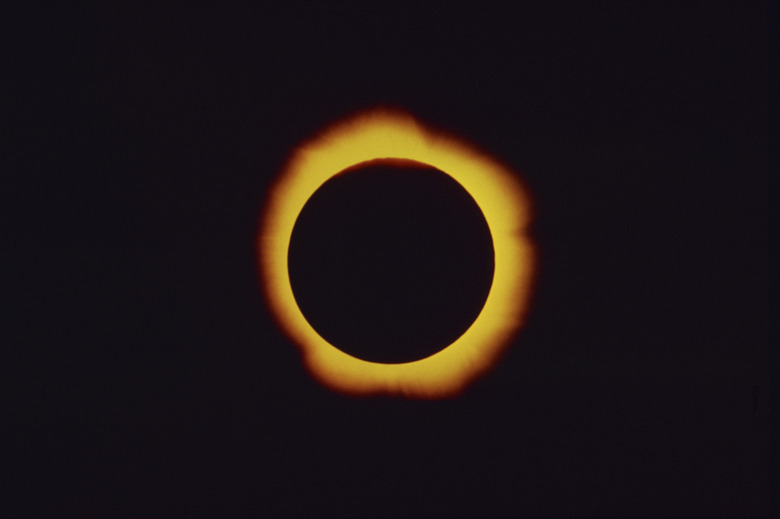Chances Of A Solar Eclipse
A solar eclipse happens when the moon passes in front of the sun and casts its shadow somewhere on Earth. The chances of a solar eclipse depend on a number of factors related to the movement of these three bodies. By tracking this complex movement, scientists can predict the time, location, duration and type of eclipse. Between two and five solar eclipses occur each year.
Types of Eclipses
Types of Eclipses
The three main types of solar eclipse are total, annular and partial. A total eclipse occurs when the moon is close to Earth; its apparent disk in the sky can block out the entire disk of the sun when it passes in front of it. An annular eclipse occurs when the moon is slightly farther away from the Earth, such that its apparent disk does not cover the entire disk of the sun. During an annular eclipse, we still see a portion of the sun's disk around that of the moon. A partial eclipse occurs when only part of the disk of the moon passes in front of the sun. A fourth, and rare, type is the hybrid eclipse. The hybrid eclipse involves both a total and annular eclipse.
Motion of the Moon
Motion of the Moon
As the moon rotates around the Earth, it travels in an ellipse. At any given time, it will variably be closer and farther from Earth. The moon's closest point to Earth is called perigee. Its farthest point is apogee. This variation in distance affects the type of eclipse that will occur, if one does. At perigee, we might see a total eclipse, because the moon will be larger in the sky. At apogee, we might see an annular eclipse, as the moon appears smaller.
The Ecliptic
The Ecliptic
The ecliptic is the line in the sky that is traversed by the bodies of our solar system. We see the sun move across the ecliptic. The moon's path, however, is slightly inclined relative to the ecliptic. It is only directly in front of the sun at the two points where its path intersects the ecliptic. This is one of the reasons we don't see a solar eclipse at every new moon.
Motion of the Earth
Motion of the Earth
The Earth, similarly, orbits the sun in an ellipse, so the sun's disk in the sky varies in size as well. When the Earth is closest to the sun, the Earth is at perihelion. When the Earth is farthest from the sun, the Earth is at aphelion. At perihelion, we are likelier to witness an annular eclipse. At aphelion, we might be able to see a total eclipse.
Eclipse Cycles and Prediction
Eclipse Cycles and Prediction
Because all of these bodies move with regularity, scientists can construct a cyclical eclipse calendar. The three determining factors in this cycle are the time between new moons, the time between perigees, and the time between moments where the moon crosses the ecliptic. All three of these intervals align every 18 years, 11 months and 8 hours. This cycle of time is called a Saros. Each Saros lasts roughly 12 to 13 centuries, and produces between 69 and 86 eclipses of various types. Typically, about 40 active Saros cycles are in effect at a time, which translates to at least two solar eclipses a year. At most, five solar eclipses may occur in a year, though this is fairly rare.
Cite This Article
MLA
Murmson, Serm. "Chances Of A Solar Eclipse" sciencing.com, https://www.sciencing.com/chances-solar-eclipse-3347/. 24 April 2017.
APA
Murmson, Serm. (2017, April 24). Chances Of A Solar Eclipse. sciencing.com. Retrieved from https://www.sciencing.com/chances-solar-eclipse-3347/
Chicago
Murmson, Serm. Chances Of A Solar Eclipse last modified March 24, 2022. https://www.sciencing.com/chances-solar-eclipse-3347/
